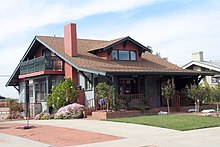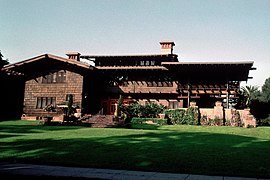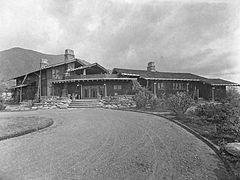American Arts and Crafts Movement
American Arts and Crafts Movement or American Craftsman Style is a style in American architecture , interior design , landscape planning , applied arts, and decorative arts that began in the last few years of the 19th century. As a comprehensive design and art movement, it was widespread until the 1930s. In addition, there have been numerous projects in decorative art and architecture up to the present day in which the style was revived or taken up.
history
British origin
The American Craftsman style has its origins in the British Arts and Crafts movement , which was founded as a philosophy and artistic style by William Morris in the early 1860s. The British movement was a reaction to the industrial revolution , with its disregard for the individual worker and degradation of human labor. It was an attempt to revalue the craft and to emphasize the value of the handicraft over mass production. The Arts and Crafts movement was also a response to the eclectic , overloaded aesthetic of the Victorian era . It was an anti-Victorian movement with William Morris, a staunch socialist . However, the expensive manufacturing, expensive building materials, and the use of costly handcrafting techniques meant that the movement's newly created works were actually reserved only for wealthy customers - an apparent contradiction of their roots in materialist dialectics and socialist philosophy. The philosophy and aesthetics of the English Arts and Crafts movement inspired a variety of related but conceptually distinct design movements across Europe as well as the American Craftsman movement in North America .
Development in the United States
While the British movement was a reaction to the Victorian era, the Arts and Crafts style didn't come until the end of the Victorian era. The American movement shared the philosophy of the reform movement, promoting originality, simplicity of form, use of local natural materials, and the recognizability of handicrafts. In contrast to the Arts and Crafts movement in Europe, it also enhanced the modest homes of the rapidly growing American middle class in America and gave rise to the Craftsman bungalow style.
The style was particularly widespread from 1905 to the early 1920s. For smaller residential buildings, Craftsman was even the dominant architectural style in some regions. It originated in California and the most important examples can be found there to this day. Popular magazines and high-volume catalogs with building templates contributed to the spread. The style lost its popularity in the mid-1920s, and was hardly used after 1930.
Boston Exhibition 1897
In the late 1890s, a group of most influential architects, designers, and educators from Boston decided to bring to America the design reforms initiated in Britain by William Morris. Their first meeting was to organize an exhibition of contemporary handicrafts. It took place in January 1897 at the Museum of Fine Arts, Boston (MFA). On site at the meeting were: museum boards of trustees, including General Charles Loring, William Sturgis Bigelow, and Denman Ross; Art collectors and patrons , writers and art critics, such as Sylvester Baxter for the Boston Evening Transcript ; Artists and architects such as Ross Turner and Ralph Clipson Sturgis. They managed to open the first American Arts and Crafts exhibition in April 1897 at Copley Hall with over 1,000 objects made by 160 craftsmen, half of whom were women. Some of the supporters of the exhibition were: the founder of Harvard's School of Architecture Langford Warren, social reformer Mrs. Richard Morris Hunt , Arthur Astor Carey and Edwin Mead, and graphic designer Will Bradley. In Boston, consumers and manufacturers recognized the aesthetic and technical potential of the Arts and Crafts style of applied arts ; it was the beginning of the design reform process.
Society of Arts and Crafts
The success of the exhibition brought about the formation of the Society of Arts and Crafts in June 1897 with a mandate to “develop and promote higher standards in the craft”. The 21 founders, including Charles Elliot Norton, put emphasis on the relationship of artists and designers with the world of commerce to encourage them to create works with the highest quality workmanship and design.
The mandate of the Society of Arts and Crafts mandate was soon expanded to a creed :
“This Society was incorporated for the purpose of promoting artistic work in all branches of handicraft. It hopes to bring designers and workmen into mutually helpful relations, and to encourage workmen to execute designs of their own. It endeavors to stimulate in workmen an appreciation of the dignity and value of good design; to counteract the popular impatience of Law and Form, and the desire for over-ornamentation and specious originality. It will insist upon the necessity of sobriety and restraint, or ordered arrangement, of due regard for the relation between the form of an object and its use, and of harmony and fitness in the decoration put upon it. "
“This society was founded for the purpose of promoting artistic creation in all branches of the craft. Its purpose is to bring designers and workers into mutually helpful relationships, and to encourage artisans to implement their own designs, to stimulate them to appreciate the dignity and value of good design, to modern impatience and the desire for overloaded ornamentation and apparent originality to counteract. Society should advocate the need for simplicity and restraint, taking into account the relationship between the shape of an object and its use. "
The Craftsman
In the United States, the Arts and Crafts style incorporated locally handcrafted, simple and elegant objects made of wood, glass, and metal. In architecture, he was the reaction to both the opulence of Victorian architecture and the increasingly widespread mass production of living space. It integrates a visible, robust structure with clear lines and natural materials.
The name of the American Craftsman movement came from the popular magazine The Craftsman , founded in 1901 by the philosopher, designer, furniture maker and publisher Gustav Stickley. The magazine featured house and furniture designs from Harvey Ellis, the Greene and Greene Company, and others. The designs, influenced by the ideals of the British movement, were inspired by specifically American forerunners such as Shaker furniture , the Mission Revival style and the Anglo-Japanese style. The emphasis on the originality of the artist and craftsman led to the later design concept of the 1930s, Art Deco .
Prominent representatives
The brothers Charles and Henry Greene were largely responsible for the development of the style. They had a craft training and were influenced on the one hand by the English Arts and Crafts movement and on the other by Asian wooden architecture. From 1893 to 1914 they ran a Greene and Greene company in Pasadena that began designing simple Craftsman-style bungalows around 1903 . By 1909 Greene and Greene had designed and built a number of style-defining examples, which they called "Ultimate Bungalows". The new Craftsman houses gained presence in high-circulation magazines such as Western Architect , The Architect , House Beautiful , Good Housekeeping , Architectural Record , Country Life in America and Ladies' Home Journal and from here found their way into relevant building plan catalogs ( pattern books ). A relatively small number of Craftsman houses that met the highest architectural standards ( high-style interpretations ) and were also referred to as "Western Stick Style" in California were offset by countless simpler versions that were affordable even for average buyers ("California Bungalows") ).
Here are some of the Ultimate Bungalows :
In Northern California, architects Bernard Maybeck with Swedenborgian Church ( San Francisco , California), Julia Morgan with Asilomar Conference Grounds, and Mills College are known for their well-planned and detailed Craftsman-style projects. Many other designers and projects represent the style in the region.
The style was also very popular in San Diego , California. Architect David Owen Dryden designed and built many Craftsman bungalows in the North Park District (now Dryden Historic District ). Built in 1905 by George Marston in Balboa Park , San Diego, the Marston House was designed by local architects Irving Gill and William Hebbard.
Frank Lloyd Wright , one of the most important and prolific house architects in the United States, was one of the founders of the Prairie School style, which as an organic architecture derives from both the American Craftsman-style aesthetic and its philosophy of quality Mid-range house design was. Wright's activities included the Victorian Style, Chicago School , American Craftsman, Prairie School , International Style, and Modern Movements. The Robie House is an example of his American Prairie School works inspired by the Craftsman style.
In the early 1900s, developer Herberg J. Hapgood built a number of Craftsman-style houses, many with stucco, in the lakefront district of Mountain Lakes, New Jersey. The residents were called Lakers , although Hapgood ultimately went bankrupt. The houses followed concise styles, including bungalows and chalets .
Architectural concept
background

Various developments in American interior design of the period are due not only to changes in taste and style, but also to the shift in patronage from the upper to the middle class. The American Victorian style is typically in the form of a two-story square house with a hipped roof hidden behind a multitude of two-story bays ; With gables and octagonal or round turrets and all-round verandas, it presents a complex facade. Typically, the exit square of the house was supplemented by a rear wing with its own entrance and staircase, where the kitchen, pantry, laundry room were housed on the first floor and the servants' rooms on the second floor. Furnished with poor quality woodwork and building materials, as well as significantly smaller bedrooms and lower ceiling heights, the Victorian servants' wing embodied the views of the aristocratic class of the Old World about class differences.
With the removal of the large bays, turrets and the rear wing, the simplification of the veranda and the lowering of the ceilings, a house in the American Queen Anne style becomes a four-square . The bourgeois housewife of the era had no domestic servants (at least none living in the same house) and is eager to do much, if not everything, of the household and raising children herself. These additional roles made it important that the kitchen was integrated into the main house and connected with simple lines of sight to the common rooms on the ground floor (dining and living room) and the backyard. Traditionally, the Victorian-era utility room was replaced by dining room furniture, often made up of built-in wardrobes, allowing local designers to incorporate wood and glass craftsmanship into the public view of the home.
Another detail that developed from the class shift of the time was the built-in dining area in the kitchen. The Victorian kitchen of the earlier era did not allow the family to look at the daily housework. It typically had a work table (with the purpose of matching modern countertops) that the servants ate at after serving the family meal and cleaning up the kitchen. The Victorian kitchen had no proper place for a family member to sit, eat, etc. Here, too, since the Craftsman-era housewife prepared the family dinner herself, Victorian cuisine gave way to a concept as the heart of everyday family life. The dining area was often arranged under a window or in its own alcove and intended as a meeting place for the family at any time of the day, especially while food was being prepared.
Typical design features
Characteristics of the Craftsman style are saddle roofs with a slight slope and a large overhang . The rafters are exposed at the edge of the roof and are never boxed ; The purlins are either exposed under the gables or false, purely decorative purlins are attached. On the facade side, the main roof usually spans a veranda that can take up the entire width of the house. The roof is supported here on two upwardly tapering columns with a square plan, which often reach down to the floor level even when the veranda is reached via a staircase. Craftsman houses are usually 1- or 1½-story, less often 2-story.
One third of the Craftsman houses have either a front gable or a side gable. Examples with crossed gables are somewhat rarer, and a hipped roof is found on less than 10% of all Craftsman houses.
Other typical features:
- 4-in-1 or 6-over-1 double pivot window
- Design elements by Frank Lloyd Wright
- handmade stone or woodwork
- Material mix throughout the building
effect
Some features of the Craftsman style were incorporated into the Contemporary style after the end of World War II , including in particular the roof design.
See also
Web links
- Craftsman Perspective The page is devoted to Arts and Craft architecture, with over 220 photos of houses including Craftsman and Mission styles.
- American Bungalow Magazine Magazine about remodeling, restoring, furnishing and living in various bungalow style houses including Craftsman.
Individual evidence
- ^ Virginia Savage McAlester: A Field Guide to American Houses. The Definite Guide to Identifying and Understanding America's Domestic Architecture . 2nd Edition. Knopf, New York 2013, ISBN 978-1-4000-4359-0 , pp. 568 .
- ^ Virginia Savage McAlester: A Field Guide to American Houses. The Definite Guide to Identifying and Understanding America's Domestic Architecture . 2nd Edition. Knopf, New York 2013, ISBN 978-1-4000-4359-0 , pp. 568, 578 .
- ^ A b Virginia Savage McAlester: A Field Guide to American Houses. The Definite Guide to Identifying and Understanding America's Domestic Architecture . 2nd Edition. Knopf, New York 2013, ISBN 978-1-4000-4359-0 , pp. 567 f .





